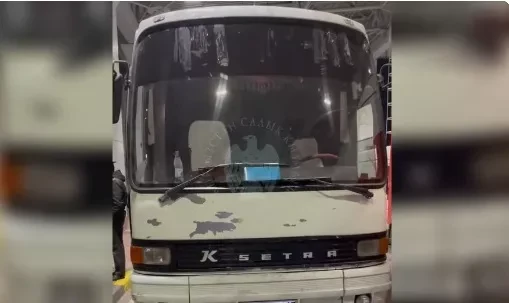Agriculture during the War Period
In writing the chapter and section on the agriculture of Kyrgyzstan during the war, materials from the consolidated annual reports of collective farms, stored in the Central State Archive of the National Economy of the USSR (fond 7486) and the Central State Archive of the Kyrgyz SSR (fond 1642—People's Commissariat of Land of the Republic) for the years 1941—1945 were used. A truthful analysis and in-depth examination of the simple yet illustrative numerical data contained in these reports allows for an objective picture of the collective farm production of the republic during those difficult wartime years.
The consolidated annual reports, which are the only source of information about the participation of workers from the Soviet countryside in public production, show the number of collective farms, the number of households, the population and its categories, the output of labor days, wage payments, the state of crop and livestock production, yield, gross harvest, supplies to the state, and the sale of agricultural products, as well as the monetary income of collective farms, the availability of basic agricultural machinery, equipment, etc.
It is necessary to consider that during the war years, due to a decrease in qualified personnel in agriculture, particularly significant difficulties arose with accountants and bookkeepers of collective farms, who were not subject to conscription.
The People's Commissar of Land of the Kyrgyz SSR, D. Turatbekov, on August 23, 1943, in sending the "Consolidated Annual Report of the Collective Farms of the Kyrgyz SSR for 1942" to the planning and economic department of the People's Commissariat of Land of the USSR, wrote: "The delay in compiling the report occurred due to the neglected state of accounting in many collective farms, and in some cases, the complete absence of accounting, as well as the lack of accountant-instructors in significant numbers in the district agricultural departments." Therefore, not all collective farms were always included in the consolidated annual reports. For example, in 1940, out of 1732 agricultural artels in the republic, 1728, or 99.8% of collective farms, submitted annual reports; in 1941—1651, or 100%; in 1942, 1620 out of 1625 collective farms were included in the report, or 99.8%; in 1943—1582 out of 1590, or 99.5%; in 1944 and 1945, all collective farms were included in the consolidated reports—1597 and 1607, respectively. The author used reporting data that were disseminated across 100% of the collective farms in the republic.
Contradictory information often appears in the annual reports of collective farms, resulting from superficial accounting analysis. For example, in the report of the "Kyzyl-Tu" collective farm in the Ivanov district of the Frunze region, it is stated that the population in 1942 was 88 people, and the working-age population, including adolescents aged 12 to 16, was also 88. This implies that there are absolutely no children under 12 years old, elderly people, or disabled individuals in this collective farm.
In the "Krasny Vostok" collective farm of the mentioned district, the annual report for 1942 lists 21 people who did not meet the minimum labor days and were excluded from the collective farm for the same reason, meaning that all of them were removed from the collective farm.
The annual reports of collective farms in this district lay in the district land department for months. For instance, the annual report for 1942 from the "Cholpon" collective farm was still not approved by the executive committee of the district council of workers' deputies in May 1943 and remained stagnant in the district agricultural department.
In writing this work, the author identified and studied documents from the Komsomol organizations of the republic, stored in the archive of the Kyrgyz branch of the Institute of Marxism-Leninism (fond 42). These include information on the mobilization of Komsomol members to the front, their combat activities, youth participation in fundraising for the front and liberated areas. The fund contains data on the valiant labor of Komsomol members and youth in industry and agriculture, Komsomol-youth brigades, two-hundred, five-hundred, and thousand-day workers, and the widespread collection of scrap metal and spare parts for tractors. A significant interest is represented by reports on the work of pioneer and school Komsomol organizations, orphanages, and the assistance of pioneers to the families of front-line soldiers.
An important support in the research was the materials from the Manuscript Fund of the Academy of Sciences of the Kyrgyz SSR, memoirs of outstanding Soviet commanders, recollections of participants in the partisan movement, letters from and to the front, and appeals and letters of instruction from the workers of the Kyrgyz SSR to their compatriots—defenders of the Motherland. In the course of the work, published documents, materials, directives, statistical sources, and historical-ethnographic books were reviewed; memoirs of front-line soldiers, Heroes of the Soviet Union, holders of the Order of Glory of three degrees, and labor leaders in the rear were widely utilized.
In writing the monograph, central and local periodicals were used: newspapers "Pravda," "Izvestia," "Komsomolskaya Pravda," "Krasnaya Zvezda," "Socialist Agriculture," republican newspapers "Kyzyl Kyrgyzstan," "Soviet Kyrgyzstan," and regional, city, and district periodicals from 1941—1945. It should be noted that documents from local, especially district, press of those years require careful verification and a critical approach.
The author expresses deep gratitude to the staff of the Central State Archive of the Institute of Marxism-Leninism at the Central Committee of the Communist Party of the Soviet Union, the Central State Archive of the National Economy of the USSR, the Central State Archive of the USSR, the Central Archive of the Ministry of Defense of the USSR, the party archive of the Kyrgyz branch of the Institute of Marxism-Leninism, the Central State Archive of the Kyrgyz SSR, the Osh regional party archive, and the state archives of Osh and Jalal-Abad, for providing the opportunity to extract invaluable documents that have not been reflected in previous studies on the history of Kyrgyzstan during the Great Patriotic War, as well as to the research staff of the Institute of History of the Academy of Sciences of the Kyrgyz SSR, and to everyone whose comments and wishes contributed to the new edition of this work.
Documents Characterizing the State of the National Economy of Kyrgyzstan during the War Years







































